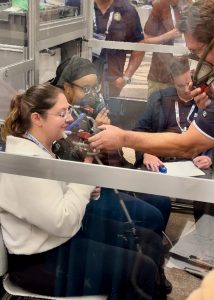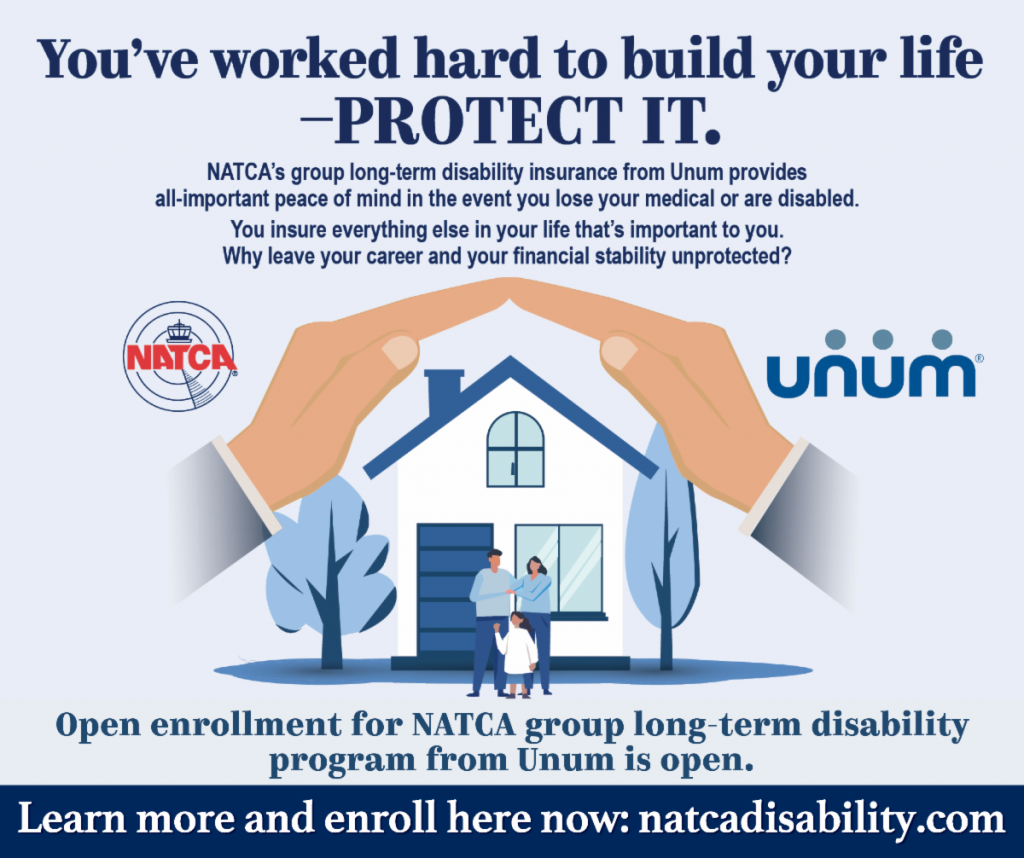
October 1st, 2024 New England Bi-Monthly Regional Update
From Kevin Curtiss, NATCA New England Regional Vice President

NATCA New England, If your ballot hasn’t made it into the mail because life can move fast and things can pile up on the desk or family appointments quickly fill your personal bandwidth, please take the time to get your ballot in the mail today. Being on the East Coast, I know there’s still time to put New England at the front of membership participation in the NATCA run-off election.
Facility leave and schedule negotiations can be a stressful time of year. We all want to know what to look forward to. It’s important to realize that getting the best agreement can take time. The Agency would love nothing more than to exert haste into the process and begin bidding. If you are starting to feel that stress, I ask that you be patient with your reps, knowing that they are working to get the best for our members.
We’ve got some great CFS write-ups in this update so I’ll be brief. The CFS planning committee put on arguably the best conference going back to before COVID. They have learned what works over the course of three days to keep interest and not allow things to get stale. It was my honor to present Sarah O’Brien and Hanan Wiseman of A90 with the 2024 Archie League Medal of Safety.

It has been a fast 30 days since becoming your RVP. Myself and ARVPs, Steve Brown and Jake Detwiler, have begun to settle in and are moving forward with planning facility visits, calls with leadership, a FacRep meeting, and evaluating how we want to communicate further. Members of New England can expect sometime in the next few weeks a membership survey that will help us understand what we need to adjust or improve to achieve success for the region.
NATCA New England will have another Controlled Chaos on October 15th and our fantastic team will have our Regional Flight Surgeon participate to answer questions commonly asked by our members. You can find more information further down in this email.

Finally, in the September 15th update, there was a post soliciting volunteers to organize a bid to bring NATCA’s convention to Boston for 2029. As I read it, I feel like it missed its mark. A few members thought this was going to be decided at CFS. NATCA New England will be making a Boston 2029 Convention bid at next year’s Convention. This bid will be for Boston to host the week leading up to St. Patrick’s Day in 2029. If you have the energy and passion to make this a reality, we need you.
If you’ve planned a General Membership Meeting, a training class, a baby shower, or a fantasy football draft, NNE wants you on the team. I believe this is an opportunity for members to be a bigger part of NATCA without jumping into a role that immediately requires a member to have a management counterpart. I look forward to putting that team together. Hit reply and let’s make this happen.
CFS Member Writeups

With the new fatigue MOU that was signed in July with an effective date no later than the development of the 2025 BWS I found this panel very interesting. The panel explained the importance of at least 12 hours off duty prior to and following a midnight shift and at least 10 hours off from the time work ends to the start of any other shift. The recommendation of 12 hours off before or after is based on your internal clock having a strong drive for wakefulness as the day goes on. The drive is particularly strong in the evening before bed. So if you’re trying to sleep during the wake maintenance zone (evening) before a mid-shift the brain keeps waking you up. Controllers have reported only getting 2-4 hours of sleep when they have time off during the day time. A 30-year-old who sleeps during the wake maintenance zone only sleeps for 75% of the time. So if you lay down to sleep for 4 hours before a mid-shift during the wake maintenance zone you will only get 3 hours of sleep. The older you are the less sleep you get during this time. A 50-year-old who lays down for the same amount of time will only get between 2 and 2 1⁄2 hours of sleep. The 12 hours before and after a mid-shift would increase the number of hours a controller would be able to sleep between shifts.
As a fan of the rattler, I was convinced listening to the panel would not change my mind. However, the number of health issues that stem from continuous chronic sleep debt was quite alarming. According to Charles Czwisler M.D., Ph.D, (Director of Sleep Medicine, Professor of Sleep Medicine and Professor of Medicine, Harvard Medical School and Chief, Division of Sleep and Circadian Disorders, Senior Physician, Dept of Medicine, Bringham and Woman’s Hospital) one week of 4-5 hours each night a man’s testosterone level declines the equivalent of 11 years of aging. Erin Flynn-Evans, Ph.D. (Director, Fatigue Countermeasure Laboratory, NASA Ames Research Center) said one week of 5 hours of sleep each night leads to healthy people looking pre-diabetic. According to Dr. Czwisler, a lot has been learned in the last decade as to how detrimental it is to our health to recurrently disrupt our circadian rhythm by changing schedules like controllers do three times a week. It is now known that it increases your risk for cardiovascular disease, heart attacks, and strokes. It increases the risk of inflammation, obesity, gaining weight, and diabetes. Mood disorders, depression, and anxiety disorders are also increased along with suicidal ideation and increased premature death. These health risks are specific to the 2-2-1 schedule. Dr Czwisler said if the panel was to sit down and design a schedule that was the most unhealthy and physiologically challenging it would be hard to come up with something worse.
I personally like the rattler because my weekend feels longer. After listening to the panel, I realize the longer weekend I have with my family now is costing me at a later date with all the health issues the rattler can cause.
-Amy Bussell, BED

I had the opportunity to attend CFS this year, which turned out to be the 25-year anniversary of the event. At the first CFS back in 1999, there were only 40-50 attendees. Now CFS draws over 1,300 people from a number of aviation fields including Air Traffic Controllers, FAA Headquarters personnel, pilots, medical professionals, and various contractors. There were several keynote speakers, panel discussions, and breakout sessions. The one event that stood out to me was the panel titled “Never Say Never… Recovering from the Unexpected.”
While the title is recovering from the unexpected, I think the panel mainly discussed the efforts of NATCA and the FAA to prepare for and hopefully avoid the unexpected (specifically runway incursions). The panel included NATCA’s Article 114 reps for Runway Safety and Surface Awareness as well an FAA QA Runway Safety Manager and a Program Manager for Surface Surveillance. The panel highlighted the low number of runway incursions compared to the actual number of takeoffs and landings across the country. But more importantly, they emphasized that it doesn’t happen by accident. They explained that NATCA and the FAA are constantly working together to maintain and improve the equipment that we rely on.
A couple of examples of maintaining and improving equipment are the implementation of the Surface Awareness Initiative (SAI) and the replacement of old Airport Surface Detection Equipment (ASDE) radars. SAI’s are basically situational awareness aids that mimic the ASDE display but are based on ADSB. The big difference is that SAI’s won’t have the safety logic alerts that the ASDE system provides. But even without these alerts, SAI should be a valuable tool at towers where they currently have no display of surface traffic. The FAA has plans to install 14 SAI’s in 4 months’ time and will ideally continue with more installations after that. For those facilities with ASDE 3 radars, you might be surprised to learn that the actual radar spinning on top of the tower was designed in the 80’s. Since then, the manufacturer has gone out of business. The FAA is currently working on finding an off-the-shelf replacement for these radars and wants to begin replacement in 2027, targeting 6-8 radar installations per year.
While the panel on runway safety was the most interesting to me, it was only one of many opportunities to learn about safety-related issues and technology affecting controllers. I found attending CFS to be a valuable experience and would recommend it to others. Next year’s CFS is scheduled for September 15-17 in Las Vegas so don’t forget to bid the time off if you’re interested.
-Jason deAraujo, BOS

I had the privilege of attending CFS this year for the first time. After many years of hesitation, I am so glad I finally went. I learned so much about the aviation industry that went well beyond just the knowledge I had as a controller. There were elected officials who spoke to us about their vision and plan for the future of the agency and our work/life balance. There were representatives from an array of technology companies and government contractors that shared with us their current and planned projects and had displays and demonstrations to share with us how they plan to contribute to and improve safety in the FAA for both pilots and controllers. The biggest takeaway for me was an experience in the “hypoxia chamber.” Junior Brown, from the Civil Aerospace Medical Institute (CAMI) guided groups of us safely through the process of experiencing what it feels like to become hypoxic.
As controllers, we are trained on the signs to look out for when a pilot may be experiencing hypoxia. Actually getting to feel it for myself in a controlled environment was invaluable. We were walked into a clear-sided cubicle that was hooked up to machines that sucked the oxygen out of the room, simulating the O2 levels at about 24,000ft. We had O2 meters on our fingers so we could keep track of our own oxygen levels as time went on. We each had an oxygen mask at the ready for when we had completed the exercise. It was time to don our oxygen mask when our O2 level dropped to 65 or we experienced three “symptoms.” Mine were dizziness, shortness of breath, and tingling in my arms and fingers.
We had speakers like FAA administrator Michael Whitaker, Nevada Congresswoman Dina Titus, and a panel that included doctors and researchers who were involved in our fatigue study.
CFS had a significant impact on my attitude toward safety and left me with valuable information that I will carry with me in the future. I look forward to future CFS conferences and highly recommend that anyone who has not yet participated seriously consider doing so!
-Rosilla Owen, ZBW
In September, I attended Communicating for Safety for the first time. I had a fantastic time. We were able to interact with different industry leaders and see what new innovations they have built and are testing at facilities around the US to improve safety in the NAS. From live airport images to runway alarms for memory aids, to airplane to airplane-to-airplane spacing communications to help with maintaining set miles-in-trail. It was great to see so many people focused on bettering the NAS and air traffic control world all in the name of safety.

I really enjoyed hearing from the keynote speakers and learning their insights on being a leader and handling mental health and stress. It was a pretty cohesive message of self-care and well-being. Some of the key takeaways I had were, in order to improve yourself overall, you need to “Be the Tree,” and take responsibility/control of your life experience and mental load. By saying “Be the Tree,” Dr. Grubb was speaking about improving oneself by taking on experiences that challenge you and can help improve your “root system” to help make you grow from the experiences.

Dr. Morgan talked about taking control of the experience of life. Encouraging you to make small changes so that when the big changes happen they aren’t as big. He also said that you wake up with a certain amount of emotional resources (energy) and it is your responsibility to determine where to spend it. Waiting on someone else to change your life/experience could be a perpetual wait.
-Caitlyn Valeri, ZBW
Announcements, Information, Upcoming Events

Submit FAA Medical questions by clicking here.


To learn more about ATX or to Register, click here.


